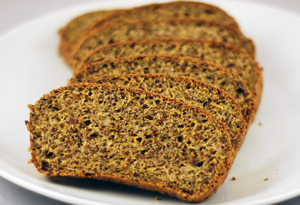 Fibre is essential for healthy digestion. It can be a bit tricky to get enough of it on a low-carb diet, when you cut out the grains.
Fibre is essential for healthy digestion. It can be a bit tricky to get enough of it on a low-carb diet, when you cut out the grains.This low-carb high-fibre bread recipe includes very high-fibre ingredients, to help ensure you get enough.
One slice of this bread contains 6.5g of fibre but only 1.8g net carbs, plus 10g of fat and 6g of protein, to a total 152 calories.
The recipe uses coconut flour, ground flax seeds and psyllium husks. It tastes very similar to standard whole grain bread! The texture is great – psyllium husks and other high-fibre ingredients bind a lot of liquids and so minimise crumbliness.
There are a couple of tricks I am using here:
- Firstly, I recommend getting unground flax (linseed) rather than ground flax meal. We all know flax is not renowned for its taste (although its nutritional value is excellent, and that’s why we use it so much in low-carb baking). I find that grinding flax just before cooking improves the taste, plus it’s easier to store whole seeds.
- Secondly, I am using sparkling mineral water to add moisture to the mix. The fizz in the water helps to make the texture a bit lighter. If you don’t have any sparkling water available, just use plain water, it will still be ok.
Low-carb bread ingredients
The main dry ingredients listed below are now available to buy from the online shop on this website (delivering to UK and EU). The wet ingredients should be easy to buy anywhere!
- 1 cup (130g / 4.5 oz) of ground flaxseeds
- 1/2 cup (50g / 1.7 oz) of coconut flour
- 1/2 cup (30g / 1 oz) of psyllium husks
- 6 large eggs (yes, that’s six eggs)
- 3 tbsp olive oil (or other vegetable oil)
- 1 cup of sparkling mineral water (or just plain normal water)
- 1 tsp baking powder
- 1 tsp salt
- 1 tsp ground black pepper
- 1 tsp xantham gum (optional)
- 1 tsp dried or freshly chopped rosemary (optional for more flavour)
Method:
- Mix all your dry ingredients together (grind your flax if you have whole seeds instead of flax meal)
- In a separate bowl, lightly beat the eggs and mix with all the other wet ingredients
- Combine dry and wet ingredients
- Pour the mixture into a greased loaf tin
- Leave to stand for 10 minutes before baking
- Bake at 190C/375F/Gas Mark 5 for about 45 minutes (or until toothpick comes out clean)
Nutritional information
Assuming 12 slices are made from the amounts above, per slice:
152 cals, 1.8g net carbs, 10g fat, 6g protein, 6.5g fibre.
Further information
Have a look at my earlier post with some generic ideas on making low-carb bread
For more low-carb baking recipes, I recommend “The Joy of Gluten-Free, Sugar-Free Baking” cookbook by Peter Reinhart:
Read my review of the book | Buy this book on Amazon (UK) | Buy this book on Amazon (US)
Products you might be interested in (delivery to UK and EU):
[wpsc_products tag=’flours’]
Hi there what size of loaf pan are you usi g for your loaf it is not specified in your recipe tks fr Gillian.
Hi when you refer to 1 Cup, could you say what that quantity translates to in millilitres please?
Hi, do you mean for the water? That would be about 250ml.
I can do “0” carb bread. Look it up on the web. It is brilliant and made from ONLY ground flax seed and eggs.
Hi Faith – flax seeds and eggs still have a little bit of carbs in them, so it wouldn’t be technically zero. But sure, you could lower the carb count further if you omit coconut flour.
Is the dough supposed to be quite sticky and wet before baking?
I greased my pan with butter, and when the bread came out of the oven it was sort of moist, especially the bottom. It remained a bit moist until the next day too, i thought it may be a tiny bit greasy from the butter, because it was really difficult to tell at that point. But then the next day the bottom and the top of the bread started getting really sticky, i would press my finger on to it and then when i detach it, thin white string would be visible, as if it is some sort of dry glue. Doesn’t really smell or taste much different . I’m pretty sure it’s some sort of mold or fungus though…
coconut flour and psyllium husks attract a lot of moisture, so could that be it? Probably not, i may have gotten something wrong, i’ll probably see what further develops on that bread and then throw it out, because i don’t feel it’s safe to eat 😀
What size loaf pan did you use?
This recipe sounds really good! I just wanted to mention that when using psyllium husk, you can omit the xantham gum (which causes intestinal upset in some people).
Thanks Tracy, I think you are right, psyllium husks are better than xanthan gum, as they are more natural.